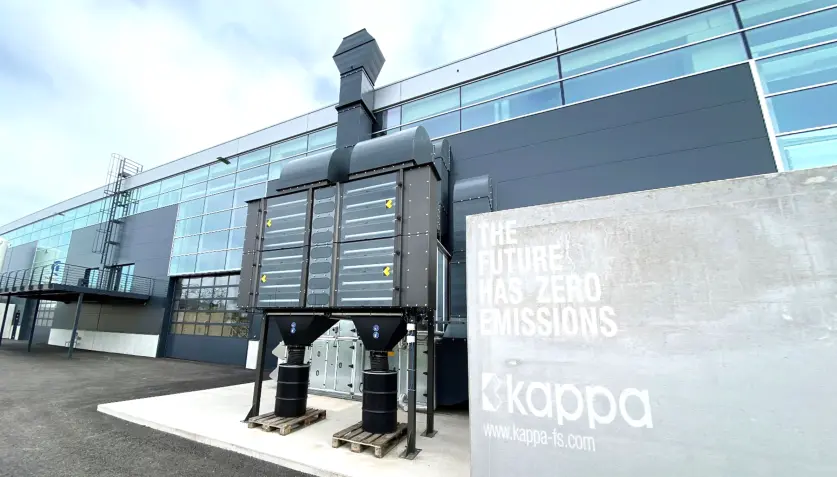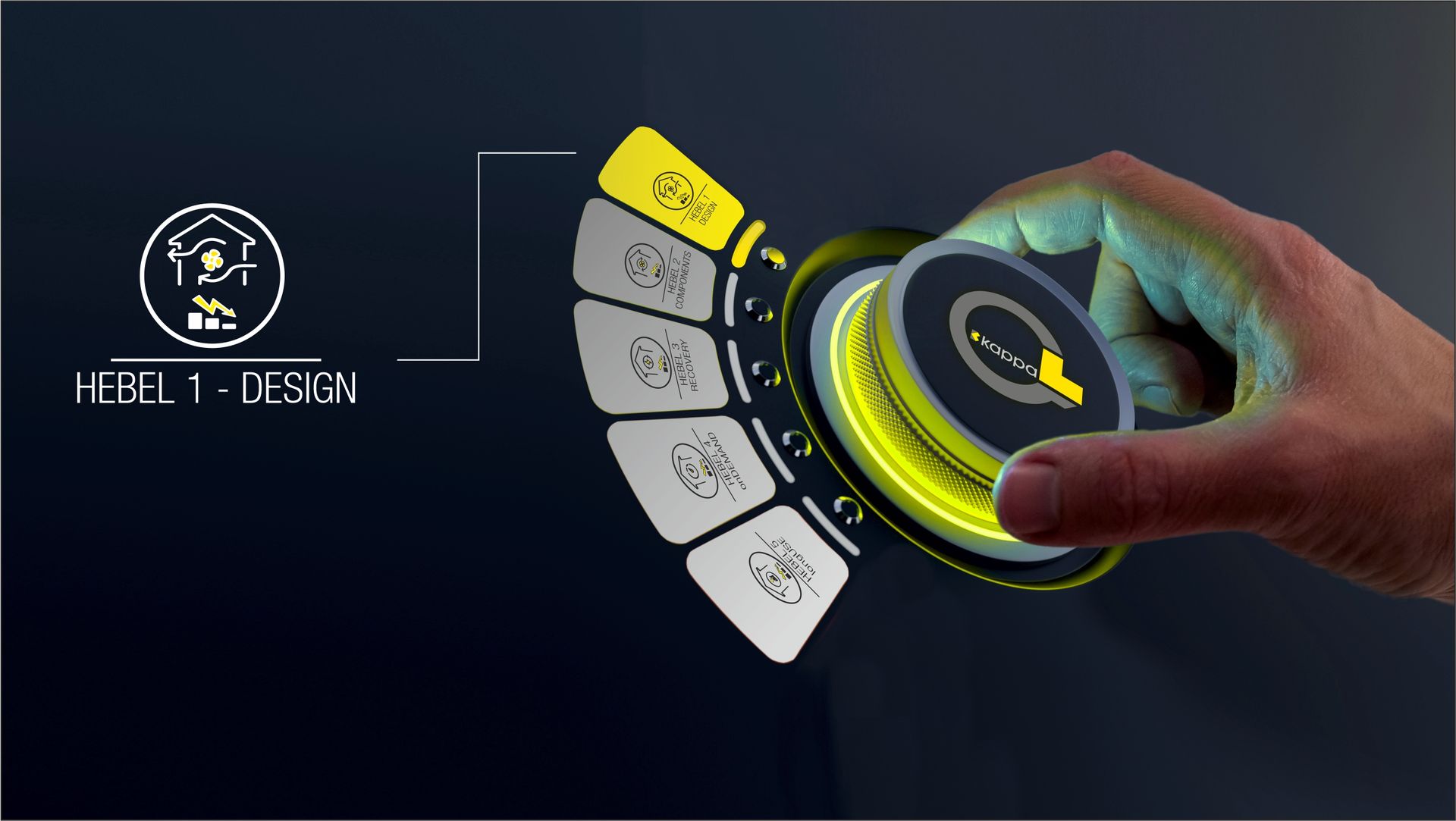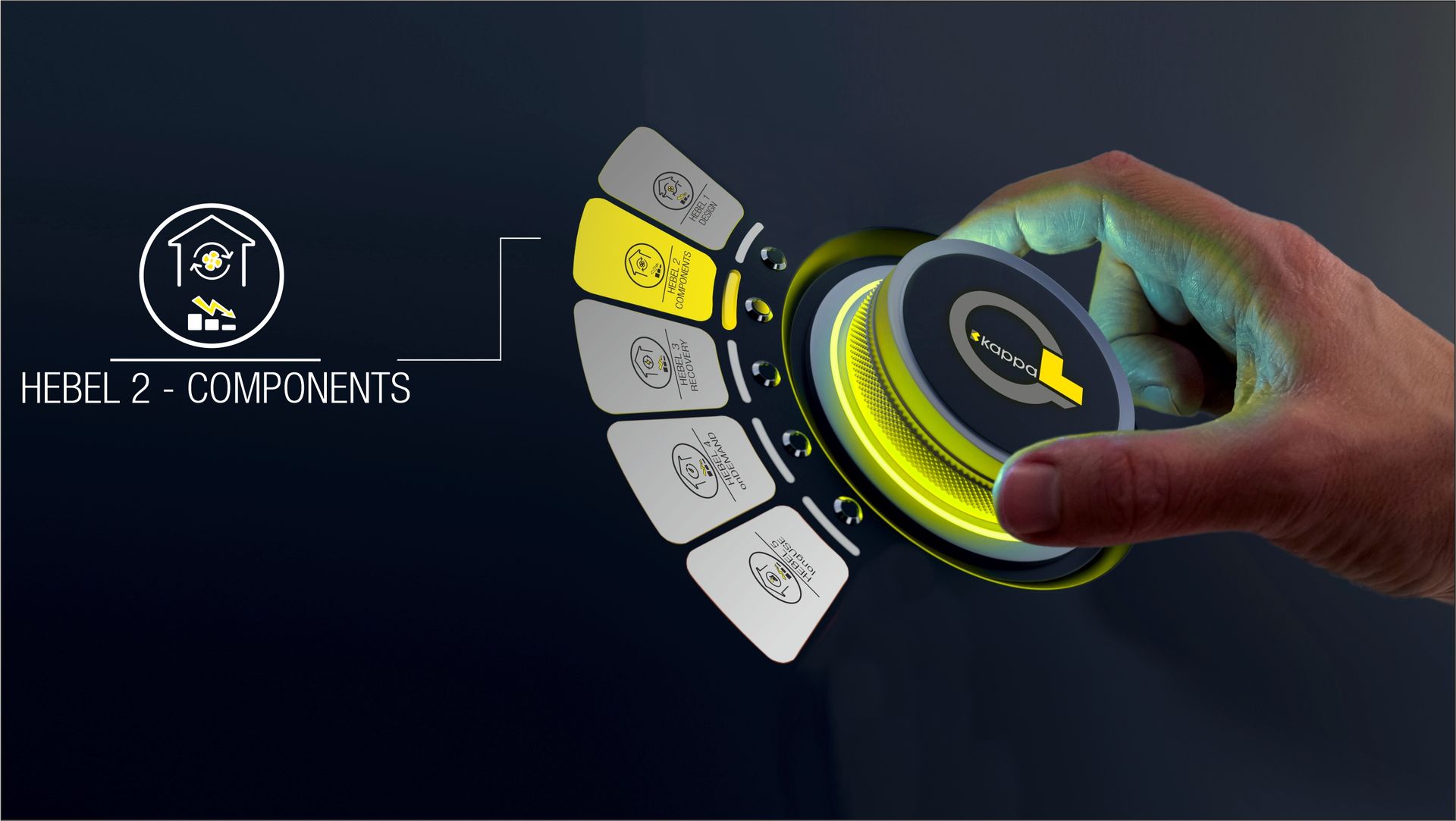Rethinking air and energy technology: systematically saving energy with KappaQ-Energy.
Energy prices are currently sparing no one. Whether in industry, commerce, the service sector or the public sector, the focus is shifting to holistic concepts for reducing energy requirements.
We have always been committed to energy efficiency and have developed a comprehensive methodology to identify and exploit all potential savings in ventilation systems. This approach has proven its worth many times over: in many projects, ambitious energy-saving targets have not only been met, but also exceeded.
Five levers to an energy-efficient ventilation system
KappaQ-Energy is the name of the holistic methodology for avoiding, saving and recovering energy. It is divided into five levers for saving energy on a large scale, both in existing buildings and in new investments: Design, Components, Recovery, onDemand and longUse.
1. The first lever, “Design”, forms the energy-efficient foundation. It describes how important the system concept and its correct dimensioning are. It is about system engineering that specifically uses energy efficiency as an evaluation criterion in addition to function when finding solutions and evaluating variants. What sounds simple in theory is often difficult in practice: always question the tried and tested! Consistently assess alternative variants according to their energy efficiency - experience is important and necessary, but can also become a brake on new ideas and innovation..
2. The second energy lever “Components” deals with the components used. A system is only as energy-efficient as its weakest link (collection, piping, drives, fans, filter elements, etc.). Only energy-efficient components should therefore be used. Above all, their interfaces and interactions with each other must also be assessed and designed to be energy-efficient.
3. The third lever, “Recovery”, is dedicated to the topic of energy recovery. After all, recovered and reused residual energy massively reduces primary energy requirements. The aim here is to determine in which areas energy resources are available and what the energy can be used for. Typical examples are the recovery of waste heat from room and hall air or process waste heat.
4. The fourth lever “onDemand” deals with the synchronization of the required air output to the current demand. Continuously adapting the output to demand significantly reduces power consumption. The aim is therefore to adapt the output of ventilation and energy systems to the required level and thus save energy. Demand control should be dynamic, as it is not enough to increase or reduce the output manually. What is needed are solutions that independently recognize what power is needed when and where.
5. The fifth lever, “longUse”, describes the energy optimization of existing systems. Kappa's experience shows that the energy efficiency of almost any ventilation system can be improved. The basis for this is an ongoing energy assessment, for example in the course of annual maintenance. Many measures can be implemented quickly and with little effort and pay for themselves in a very short time.
Case study
The effectiveness of the model is demonstrated by the example of a medium-sized, owner-managed steel and apparatus manufacturer. With the help of the 5 levers, it was possible to develop a holistic air and energy technology solution that leads to significant energy savings. The company relies on modern production and processes. The production portfolio is broad - it ranges from classic sheet metal cutting, precision welding and surface treatment to assembly. Decentralized ventilation units were already in use in the halls for ventilation and extraction, and emissions were removed via extraction and filter systems.
Nevertheless, the employees' exposure to emissions and temperatures was high - the halls overheated and became polluted, it was too hot in summer and cold in winter.
Approach and solution
Together with the customer, Kappa Filter Systems launched an engineering project to assess the current situation and define the future target state. Solution variants were developed and compared, including their energy costs. Based on calculations and simulations, the system was designed to the point, the ideal solution was found and implemented: all areas are now supplied with fresh air, emissions and waste heat are removed from the halls. Fine dust from steel construction is separated in the fine dust filter, while emissions from machining are separated in aerosol separators.
The waste heat from the entire exhaust air flow, including the assembly areas, is recovered to heat the fresh air, which is supplied to individual areas at a controlled temperature.
A heat pump was installed to cover temperature peaks, which is fed with electricity from the building's own PV system on the roof. The customer also has the right to use an adjacent stream from which cold water can be drawn for cooling in summer. This means that no additional cooling costs are incurred. All six halls are supplied with fresh, clean air, emissions are removed and the halls are heated and cooled. All functions are integrated into one overall system. This has created clean, bright and attractive workplaces - and saved energy at the same time.
Results
A total of 314,351 kWh of electricity and 392,000 kWh of heating energy can be saved annually with the 5 levers.




